MXA RACE TEST: THE REAL TEST OF THE 2024 KTM 350SXF
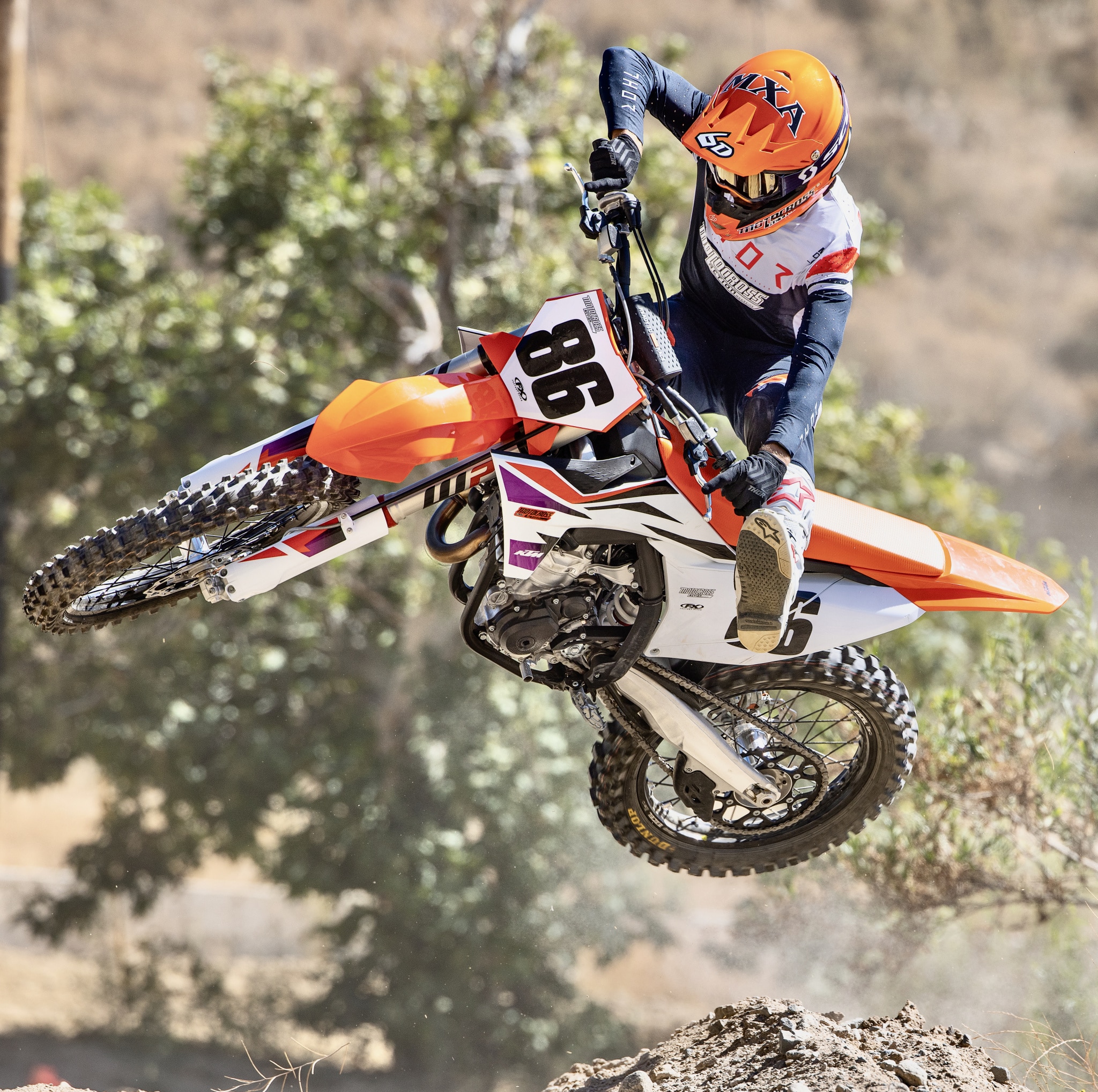 The KTM 350SXF is the perfect balance of chassis, power and handling. THE GEAR: Jersey: Thor MX Prime, Pants: Thor MX Prime, Helmet: 6D ATR-2, Goggles: Scott Prospect, Boots: Alpinestars Tech 10.
The KTM 350SXF is the perfect balance of chassis, power and handling. THE GEAR: Jersey: Thor MX Prime, Pants: Thor MX Prime, Helmet: 6D ATR-2, Goggles: Scott Prospect, Boots: Alpinestars Tech 10.
Q: FIRST AND FOREMOST, IS THE 2024 KTM 350SXF BETTER THAN THE 2023 350SXF?
A: Yes, largely because it is fresh, but if you own a 2023 KTM 350SXF, there is no pressing need to run out and buy a 2024 model.
Q: AREN’T ALL THE 2024 KTMs JUST BNG BIKES?
A: Of course they are, but guess what? So is the 2024 Yamaha YZ450F, 2024 Yamaha YZ125, 2024 Yamaha YZ250, 2024 Honda CRF450, 2024 Honda CRF250, 2024 Suzuki RM-Z450, 2024 Suzuki RM-Z250, 2024 Husqvarna FC450, 2024 Husqvarna FC350, 2024 Husqvarna FC250 and 2024 Kawasaki KX250.
This is the year of “Bold New Graphics” (BNG), because the only 2024 motocross bikes that are all new are the Yamaha YZ250F, Kawasaki KX450 and all of the 2024 GasGas models.

Q: DID THE 2024 KTM 350SXF GET ANY CHANGES FOR 2024?
A: Yes, indeed they did. Most noticeably, the price tag jumped from $10,699 last year to $10,899 this year. What did the $200 upcharge buy?
(1) Bold new graphics. The BNG includes an orange rear fender instead of 2023’s white rear fender, white fork guards instead of last year’s orange fork guards and radiator shroud graphics that are not only more colorful, thanks to a splash of purple, but have replaced last year’s large KTM logo with a tiny one.
(2) Suspension. On the forks, WP made “minor refinements” to the compression shim stack to make the mid-valve damping feel more fluid and comfortable. On the shock, WP developed new high-speed compression damping settings that enabled smaller adjustments per dial movement. How much smaller? Each incremental change was reduced by 50 percent.
Q: HOW DOES THE 2024 KTM 350SXF RUN ON THE TRACK?
A: We can’t explain why, because there are no technical explanations, ECU updates or dimensional changes to account for it, but the 2024 KTM 350SXF pulls harder and longer in the middle than it did last year. It is more responsive down low, which helps the 350SXF engine leapfrog into the midrange where it continues to rev to its ultra-high peak. The 350 configuration delivers the best of both worlds. It picks up quickly down low, pulls steady through the middle and revs to an amazingly high rev limiter.
Although the 2024 KTM 350SXF can be lugged down low, to get the best out of the mid-size engine, you have to rev it. MXA test riders alway tell first-time 350SXF riders that the key to success on the 350SXF is to “never shift,” because the best power is way, way, way up on top, so shifting early is the same as sticking a rag in the airbox. Wait for the revs to build, wait for the rev limiter to kick in and then slam in another gear.
Q: WHAT’S NEW ON THE 2024 WP XACT SUSPENSION?
A: WP reworked the forks and shock for the 2024 350SXF with the goal of increasing comfort and adjustability at both ends. Both the shock and fork valving are slightly different from the 2023 production fork, but the changes are limited to specific segments of the stroke in places where WP felt they could make the suspension less finicky to setup changes.
Forks. WP says they made “minor refinements” to the compression shim stack to make the mid-valve damping feel more fluid and comfortable. They did not touch the rebound side of the fork’s damping, nor are there any alterations to the suggested air pressure or clicker settings—just that the rider should be willing to fine-tune the feel by making clicker adjustment based on track conditions.
Shock. The WP technicians developed new high-speed compression damping settings because they felt that the previous settings had gaps that were too large per adjustment. WP’s goal was to get the high-speed compression dial to make smaller adjustments per dial movement to reduce the damping effect per click by 50 percent. This change was achieved by increasing the number of shims in the high-speed stack from 15 to 23 shims—the increase in the shim stack made each adjustment smaller—and offered the rider twice as many options.
The key to success on the 350SXF is to “never shift,” because the best power is way, way, way up on top. Shifting early is like sticking a rag in the airbox.
Q: HOW DID WP AIR FORKS GET SUCH A BAD RAP?
A: The only riders who seem capable of co-existing with the KTM air forks are the MXA test riders and the KTM factory riders, who ran stock 48mm WP XACT air forks on their 2023 AMA National bikes. No surprise! Aaron Plessinger ran stock production forks on his 450SXF in the 2022 AMA 450 Nationals also.
KTM and WP are to blame for the public’s general dislike for WP air forks, but that is because the first couple of generations of WP air forks, starting in 2017, were less than stellar (albeit better than the 4CS forks that came on KTMs in 2016). As riders struggled with the earlier versions of KTM’s air forks, they inundated social media with their complaints—and the bad news stuck. And, it stuck even though WP made massive gains in overall fork performance starting in 2021 with the introduction oil bypass notches, bypass holes in the air seal to lessen air pressure spikes and the “trampoline valve.”
Most internet experts complaining about the WP XACT air fork haven’t raced with the latest version, or if they have, then they failed to understand that the air pressure is just a replacement for the coil spring. It does not do anything else. Once you find the proper air pressure for your speed, weight and local track, you should focus on the compression and rebound clickers to fine-tune the overall feel.
The 2024 KTM 350SXF forks are very good—when set up properly. Do we think that the Kayaba SSS forks on the Yamaha are more absorbent and follow the ground better than the KTM WP forks? Yes, and we have said so in every test since SSS forks were introduced back in 2006, but perhaps the one thing that we should have said is that the SSS forks are also more absorbent and follow the ground better than the coil-spring forks on the Honda, Kawasaki and Suzuki.
One thing that never gets any play is that air forks save over 3 pounds of weight on the front of the bike—and that is a benefit of epic proportions. MXA test riders know this intimately, because we are constantly switching back and forth between stock WP air forks and expensive WP Cone Valve forks, which more than prove that WP is capable of building superior coil-spring forks for a price. No matter how well the Cone Valves work, every test rider mentions the negative effect of the added weight.
Q: WHAT ABOUT THE WP REAR SHOCK?
A: The WP shock is one of the easiest shocks to live with. It comes from the WP factory in Munderfing, Austria, ready to rock and roll. The stock clicker settings for compression and rebound are in the ballpark for everyone from the a fast Pro to a slow Vet (within a range of two to three clicks).
However, we must confess that MXA’s pro test riders feel that the rear shock needs increased compression damping at the very end of the stroke where it delivers a last-second jolt on any hard landing (and often kicks in square-edged bumps). Vet and Novice test riders rarely complained about the shock bottoming on landings, but we tried a re-valve at the end of the stroke, and we tried stiffer, heat-cured foam bumpers on the shock shaft, but by serendipity, Pro Circuit, AEO/REP and Luxon MX introduced aftermarket shock linkages that made the WP shock softer initially and stiffer at the end of the stroke (the exact opposite of the stock KTM shock linkage).
The aftermarket links are expensive, and some require a stiffer shock spring. If you don’t want the added expense of the aftermarket links, try more low-speed compression damping to help with hold-up or send the shock to your favorite tuner—and have him focus on more compression damping in the last 25 percent of the shock’s travel.
Q: HOW DOES THE 2024 KTM HANDLE?
A: When it comes to overall handling, not just cornering prowess or straight-line stability but the total envelope of motocross racing, the 2024 KTM 350SXF is the cat’s meow. After the long break-in time for the frame (approximately 10 hours), this bike can do anything. It can carve like a Suzuki RM-Z450, but without the head-shake at speed. It can cross rough ground at high speed like a pre-2023 Yamaha YZ450F, but without the bulk. It can feel ergonomically perfect, like a Honda CRF450, but without the twitch. Plus, its anti-squat chain line means that it can rocket out of rutted turns without the jackhammer feel of too much chain torque.
With the frame’s backbone separated from the shock tower, all the energy from hard landings and big bumps is redirected down the parallel frame spars (instead of into the backbone in the direction of the head tube). KTM’s chromoly steel tubing dissipates the blunt-force trauma before the harshness gets to the rider. Long story short, the 2024 KTM 350SXF frame is better at soaking up braking and acceleration bumps better than any aluminum frame.
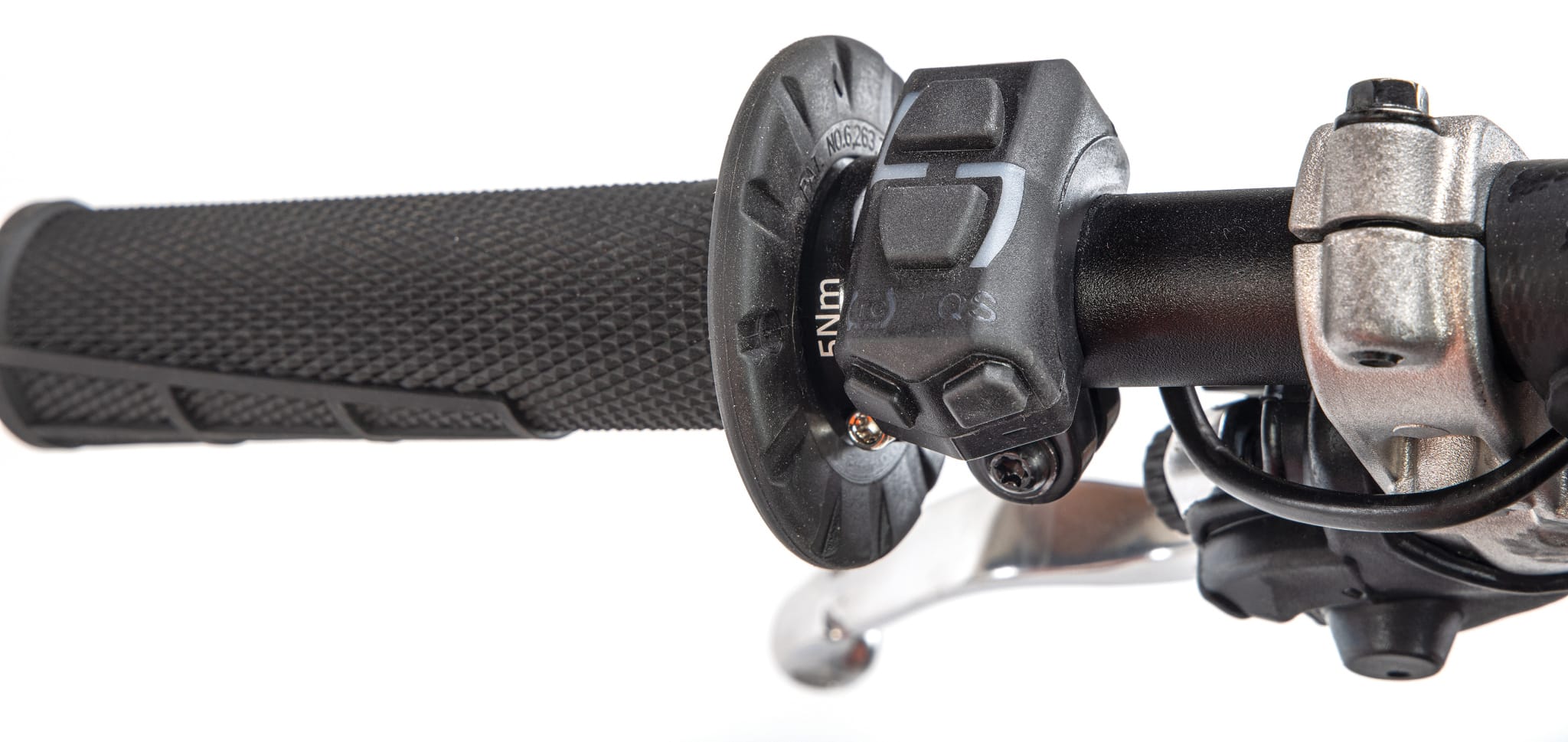
Q: IF CHROMOLY FRAMES ARE BETTER, WHY DON’T THE JAPANESE BRANDS USE THEM?
A: Casted and forged aluminum frames are made out of a handful of major components, sometimes as few as 10 major pieces. Those pieces can be plugged together and robot-welded together lickety-split. Additionally, the aluminum frame will heat-treat itself in the container ship on the way across the ocean. Aluminum frames are much cheaper to build (once you amortize the casting costs).
Chromoly steel frames need expensive steel tubing made from alloys containing chromium, molybdenum, iron and carbon in different ODs and lengths. That tubing must be cut, bent, mitered, gusseted, welded, heat-treated, cold-set and painted. As you can imagine, just the labor involved in making a chromoly steel frame is expensive, and the steps are time-consuming.
Originally, aluminum frames were lighter than steel frames, but as questions arose about the durability of aluminum, the manufacturers started using more and more forged parts, which added weight in the head tube, shock tower, swingarm pivots and cross braces, resulting in chromoly steel frames being lighter.
There are lots of market forces at work when it comes to choosing chromoly or aluminum, and it is no surprise that KTM would choose steel over aluminum, despite its labor-intensive construction, or that Honda, Yamaha, Suzuki and Kawasaki would choose aluminum given its manufacturing and price benefits.
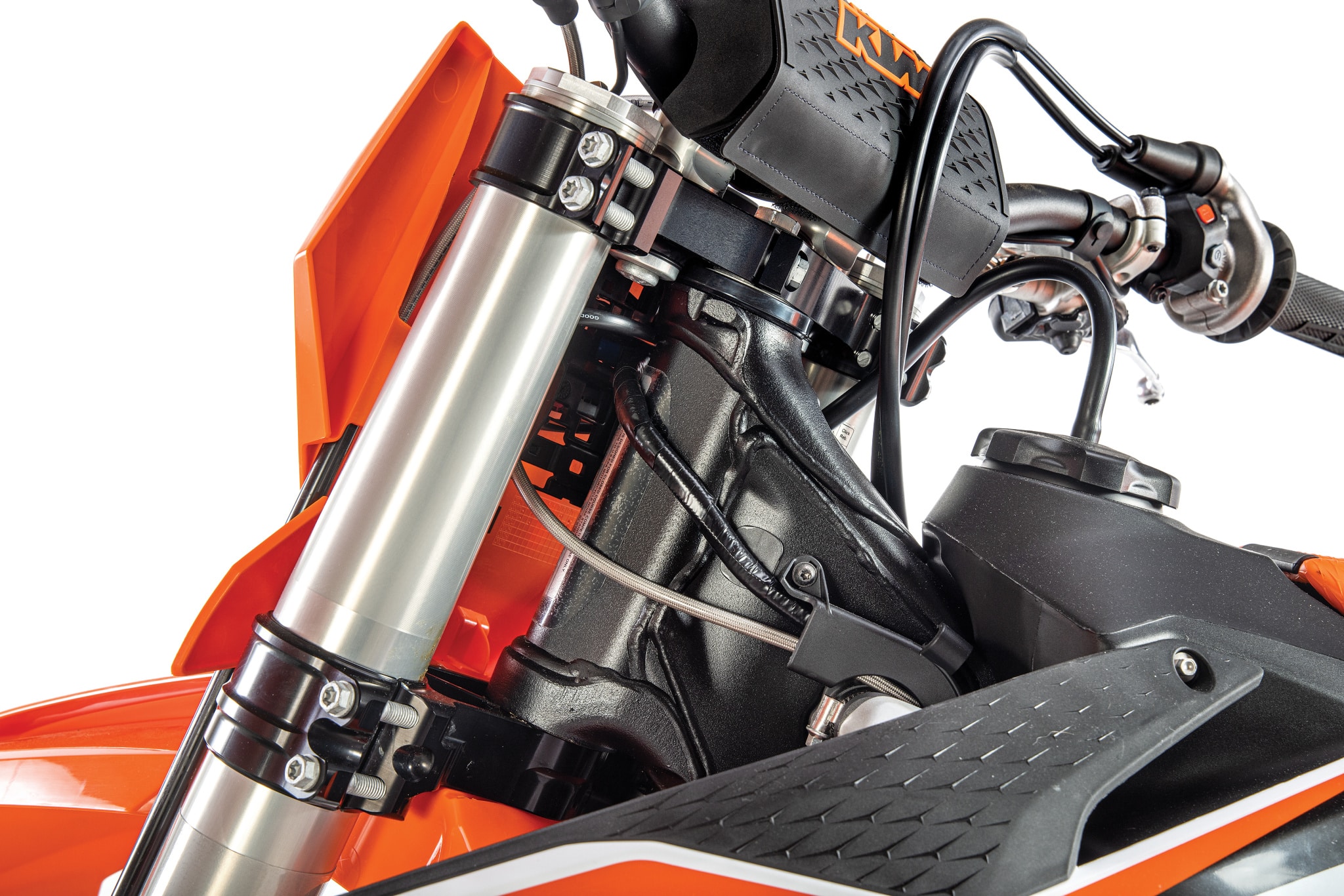 You can choose the type of handling you want by sliding the forks up and down in the clamps.
You can choose the type of handling you want by sliding the forks up and down in the clamps.
Q: WHAT DID WE HATE?
A: The hate list:
(1) Wheel spacers. Unlike on the last 20 years of KTMs, you cannot run your older spare rear wheels on the 2023–2024 models without changing the seals and spacer tube. Luckily, Nacstar (www.nacstar.com) makes retro-fit wheel spacers that allow older-model wheels to fit on the 2023–2024 KTMs. They retail for $14.95,
(2) Finding neutral. Getting the transmission into neutral on the starting line is very hard. MXA test riders rev the engine with the clutch pulled in and when the rpm peaks. We snick the shift lever into neutral as the rpm drops.
(3) Gas cap. The gas cap sticks.
(4) Start/stop buttons. If you don’t like having the kill button on the right side of the handlebars, Nihilo Concepts makes separate start and stop buttons that retro-fit so you can put the kill button wherever you want it.
(5) Seat height. It seems strange that KTM makes Husqvarna motorcycles that are lowered, but each year they makes their bikes taller. The 2024 KTM 350SXF is step-ladder-tall.
(6) Spokes. KTM’s spokes come loose all the time. If you can’t check all the spokes, be sure to check the spokes closest to the rear rim lock. If those spokes are loose, you need to tighten all the spokes.
(7) Chain slack. The KTM 350SXF has set a new chain-slack standard. Forget about three fingers under the chain at the rear of the swingarm buffer pad; the 2024 KTM needs four fingers (approximately 70mm of slack). The chain is not right if it doesn’t look too loose. If you don’t set the slack at 70mm, the chain will eat the front edge of the chain buffer pad and keep on chewing through the swingarm.
(8) Brake-pedal tip. It gets crushed, bent, or broken in any crash or collision you have. There are much stronger aftermarket tips available.
(9) Clutch cover. It’s painted black until your boot starts wearing through the paint.
(10) Washing. The giant air vents below the seat are hard to seal off when you pressure-wash your bike. We run Twin Air’s plastic airbox covers to avoid getting water in the engine.
(11) Radiator cap. The new plastic minicycle-style radiator cap is very hard to twist open because of its small diameter. We like the old-style radiator cap (and obviously so does the KTM race team).
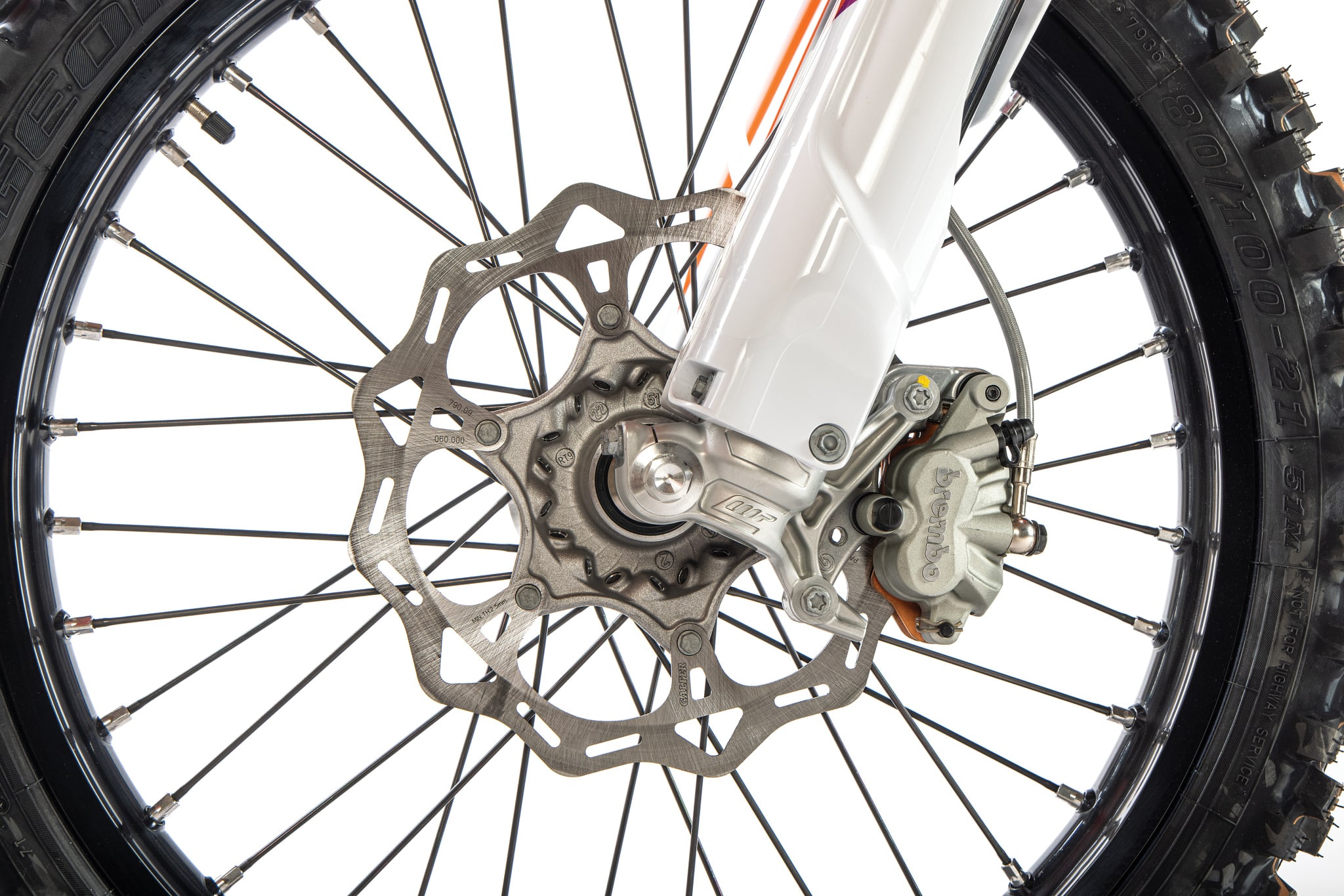 The Brembo brakes are so good that even the Japanese brands are spec’ing them now.
The Brembo brakes are so good that even the Japanese brands are spec’ing them now.
Q: WHAT DID WE LIKE?
A: The like list:
(1) Gearing. If you want more low-to-mid thrust, add one tooth to the rear sprocket.
(2) No-tools clickers. You can adjust the WP shock and forks without ever using a tool. Low-speed compression, high-speed compression, shock rebound, fork rebound and fork compression are all adjusted by hand. The rebound clicker on the bottom of the shock is blocked by the linkage arms, but it has a slot for a flat-bladed screwdriver.
(3) Brembo hydraulic clutch. We like the “pop” feel of the Brembo master cylinder.
(4) Air filter. KTM’s air filter design, with its plug-and-play installation, no-tools airbox cover and no need to remove the seat, makes it the best design ever.
(5) Brembo brakes. Someday, Nissin will catch up to Brembo when it comes to well-modulated, powerful and one-finger braking, but given that the 2024 Kawasaki KX450 comes with a Brembo front brake (rotor, caliper, master cylinder and lever), it looks like Nissin has been asleep at the wheel.
(6) Quick Shift. It’s great for long high-speed starts, but can be quirky in half-throttle situations. KTM says that you can turn it on and off on the fly, but you’d be risking your life to try to find it at speed.
(7) Wider front fender. The 2023–2024 front fender is 1 inch wider and comes with four 1-inch winglets on the back half of the fender to widen the rear of the fender without cutting down on airflow to the radiators.
(8) Maps. Map 2 is a great map. It is smoother off the bottom with reduced engine braking and very linear power that takes off in the middle and goes until the blood rushes out of your brain. Map 1 is for the racer not in a rush.
(9) Shock collar. The easier-to-turn shock collar is a big improvement over the old sticky one. Thank you, WP.
(10) Air forks. The WP XACT air forks work great if you take the time to set them up for your weight and speed.
(11) Frame guards. It’s nice that KTMs come with plastic frame guards, but half of the MXA test riders take them off to make the bike narrower at the footpegs.
(12) Drivetrain. The 2024 KTM 350SXF has a great engine, great clutch and great transmission.
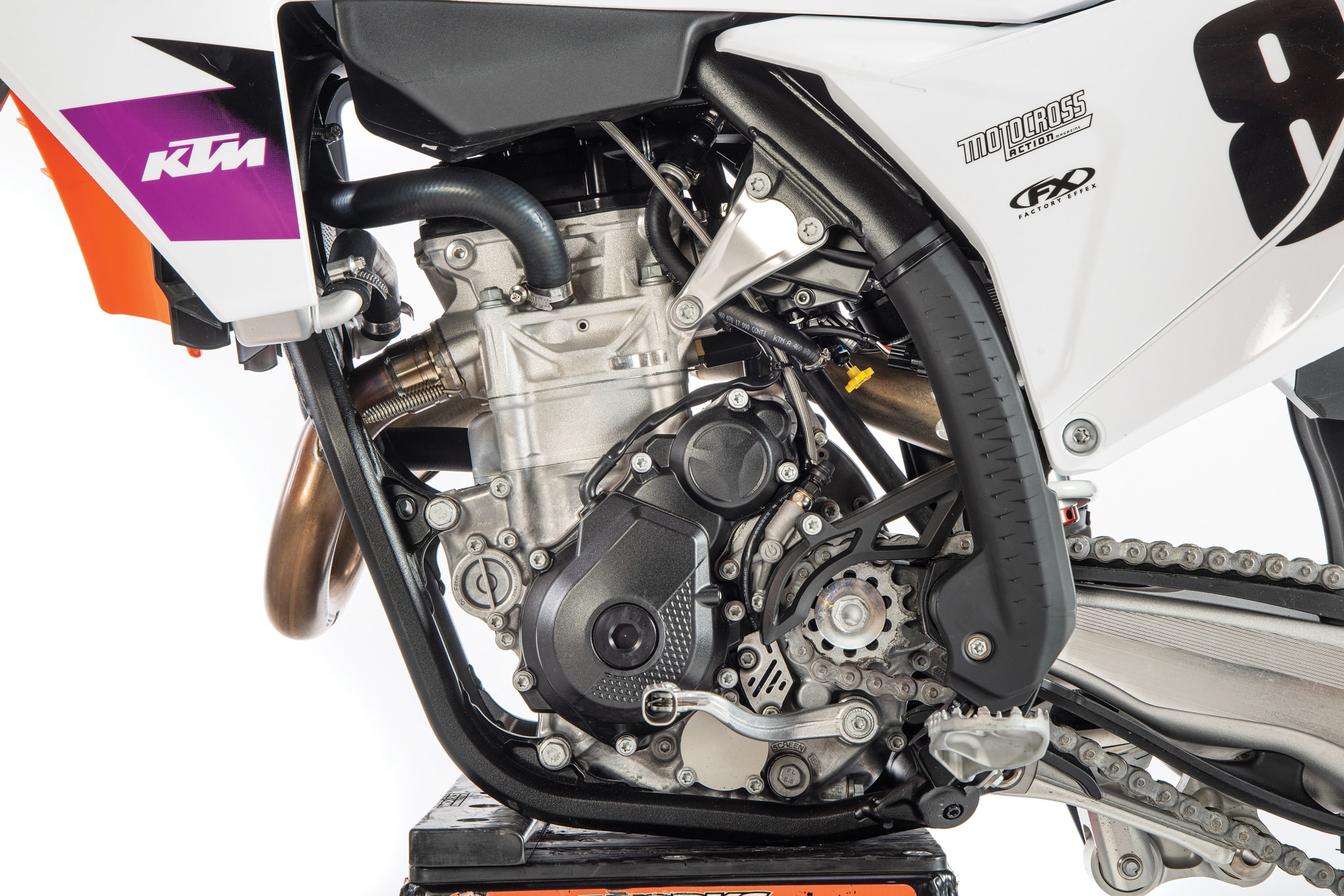
Q: WHAT DO WE REALLY THINK?
A: The MXA wrecking crew firmly believes that the 2024 KTM 350SXF is the best all-around motocross bike on the track today. That doesn’t mean that it’s the best bike for everyone, but it’s the only full-size motocross bike that can be ridden flat out at high rpm like a 250 or torqued in the midrange like a 450. It revs to 13,000 rpm, which means you don’t have to shift if you don’t want to. The KTM 350SXF is as close as a four-stroke can get to the feel and sensation of a racing 250 two-stroke.
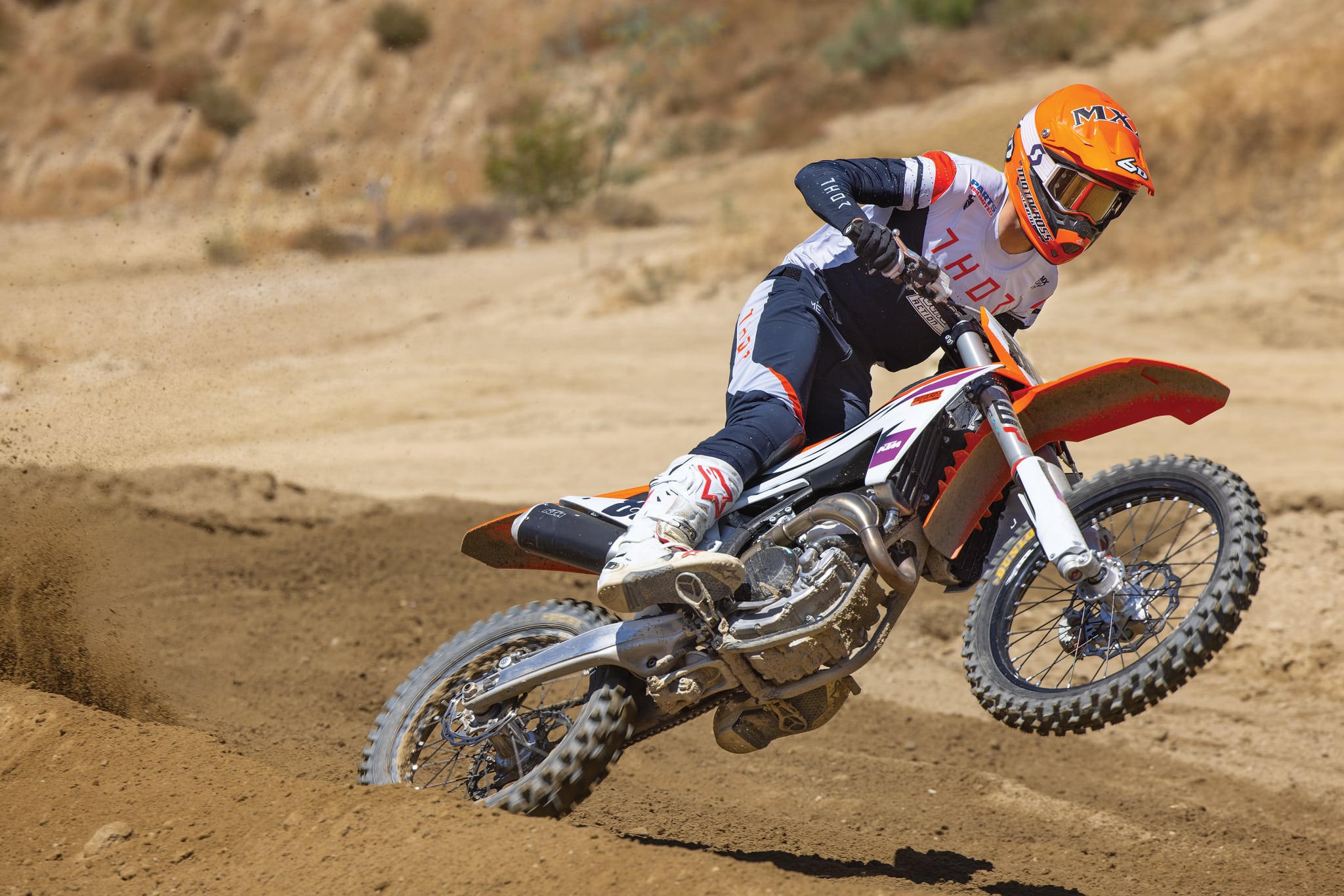 The 2024 KTM 350SXF is the best all-around motocross bike on the track today.
The 2024 KTM 350SXF is the best all-around motocross bike on the track today.
MXA’S 2024 KTM 350SXF SETUP SPECS
This is how we set up our 2024 KTM 350SXF suspension for racing. We offer it as a guide to help you find your own sweet spot.
WP AER FORK SETTINGS
There is a learning curve to getting the most out of the WP XACT air forks. KTM has a sticker on the air leg to guide you to the recommended air pressure. It is a good starting point, but it’s just a suggestion, not an ironclad law. MXA has test riders who run as much as 165 psi and test riders who run as low as 135 psi. The 2024 forks have the potential to be great. For hardcore racing, we recommend this fork setup for an average rider on the 2024 KTM 350SXF.
Spring rate: 158 psi (Expert), 152 psi (Intermediate), 145 psi (Vet), 138 psi (Novice)
Compression: 14 clicks out (12 clicks out)
Rebound: 15 clicks out (18 clicks out)
Fork-leg height: Third line
Notes: We run a zip-tie on the right leg to measure fork travel (we don’t trust the orange rings), which is an indicator of whether you have too much or too little air pressure.
WP SHOCK SETTINGS
Most MXA test riders like the overall feel of the WP rear shock. WP did make some technical changes to the 2024 shock to make high-speed compression damping less finicky. We run the low-speed compression on 15 clicks out, the high-speed compression 1-1/2 turns out, the rebound on 15 clicks out and set the sag at 105mm. For hardcore racing, we recommend this shock setup for the 2024 KTM 350SXF:
Spring rate: 45 N/mm (for 175 and up pounds), 42 N/mm (for riders under 175 pounds)
Race sag: 105mm
Hi-compression: 1-1/2 turns out
Lo-compression: 15 clicks out
Rebound: 15 clicks out
Notes: When we have doubts about the shock’s compression damping, we focus on changing the high-speed compression—not the low-speed. We also choose to run the Pro Circuit KTM shock linkage (with a stiffer 5.0 N/mm shock spring). The stock KTM shock linkage starts out stiff and gets softer as it goes through its travel. The Pro Circuit link starts out soft and gets stiffer as it nears the end of the shock’s stroke.


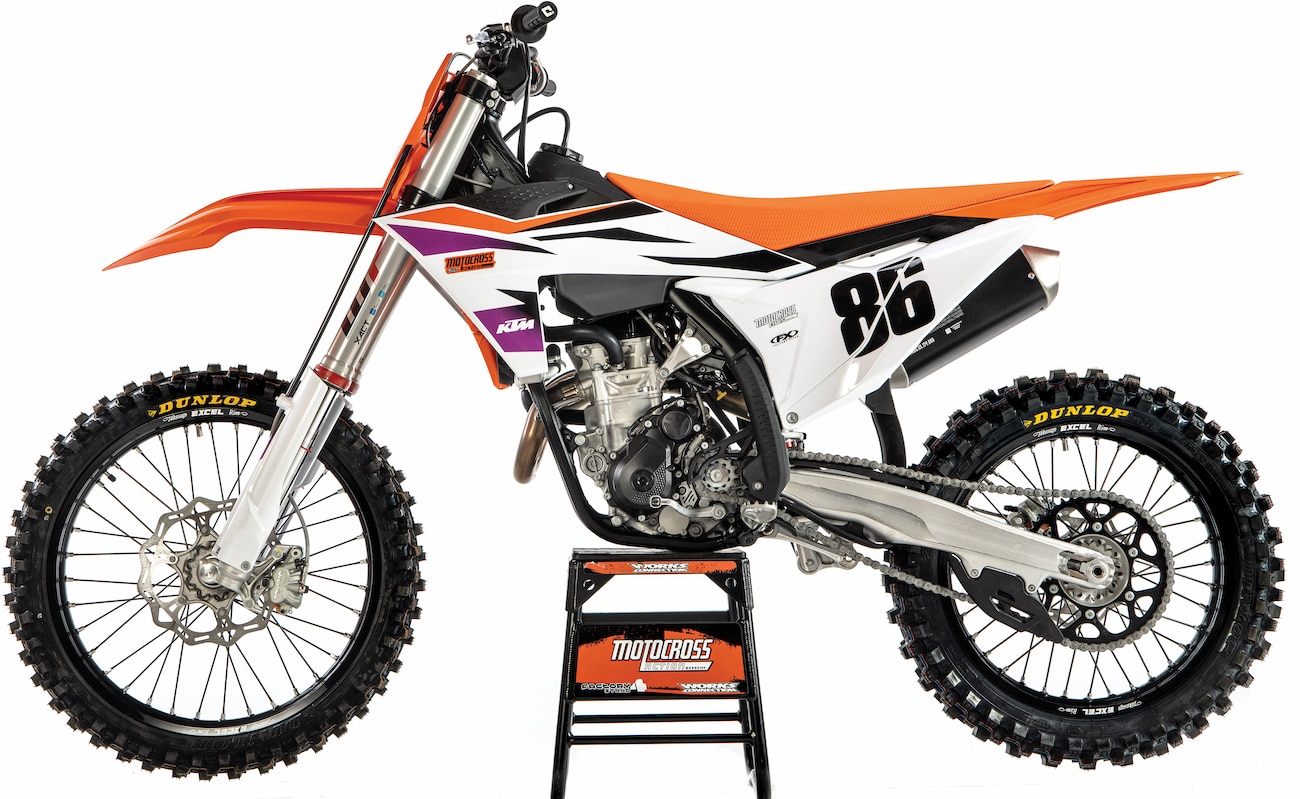
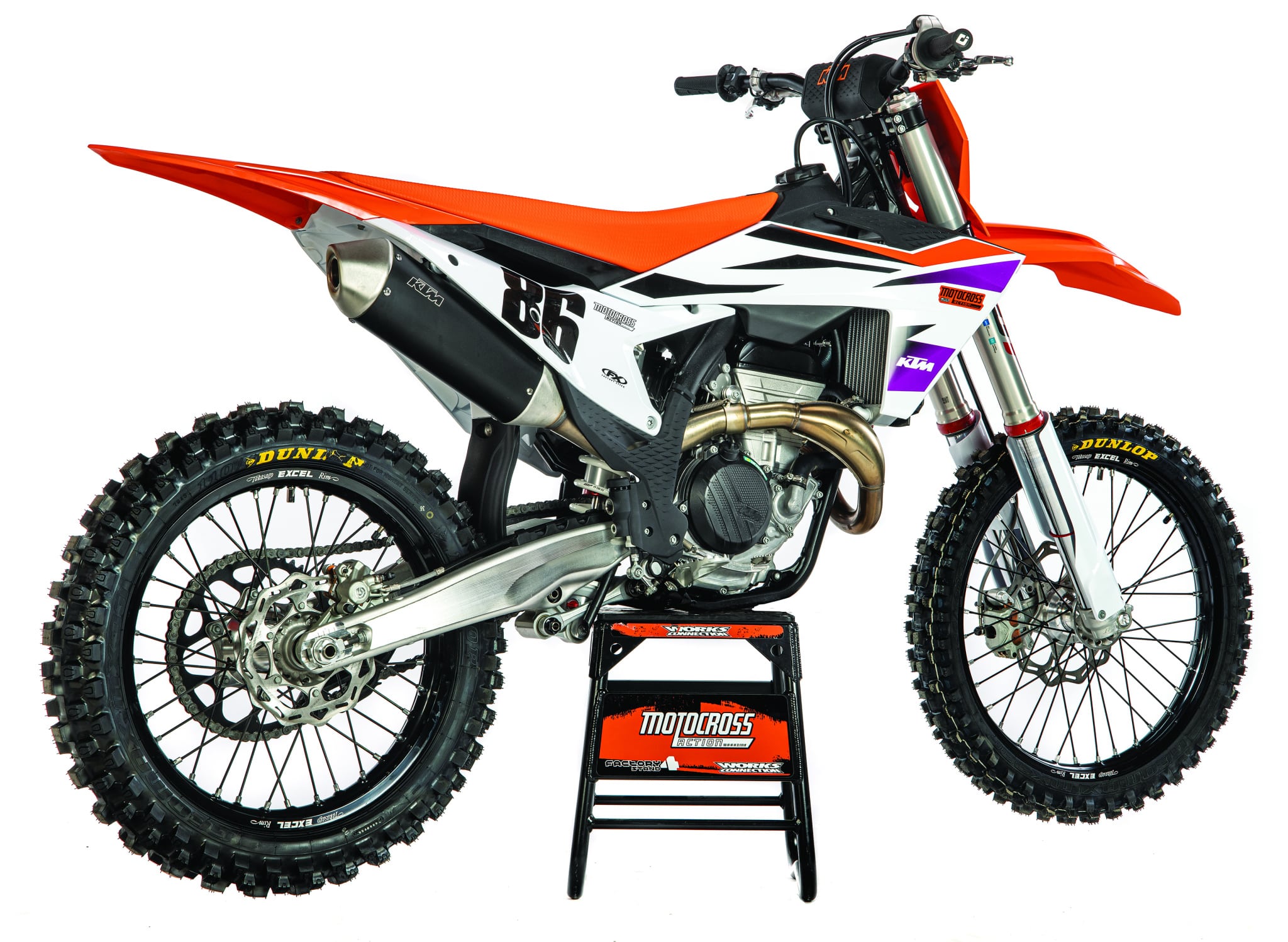





Comments are closed.